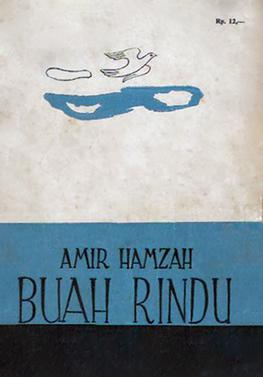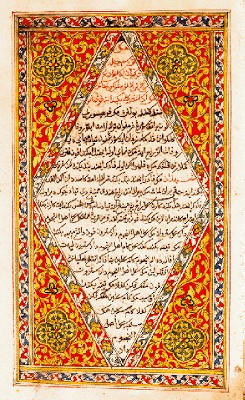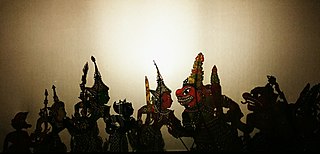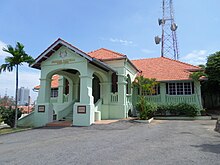
Malays are an Austronesian ethnoreligious group native to eastern Sumatra, the Malay Peninsula and coastal Borneo, as well as the smaller islands that lie between these locations. These locations are today part of the countries of Malaysia, Indonesia, the southern part of Thailand, Singapore and Brunei Darussalam.

In book publishing, an anthology is a collection of literary works chosen by the compiler; it may be a collection of plays, poems, short stories, songs, or related fiction/non-fiction excerpts by different authors.

Pantun is a Malayic oral poetic form used to express intricate ideas and emotions. It generally consists of even-numbered lines and based on ABAB rhyming schemes. The shortest pantun consists of two lines better known as the pantun dua kerat in Malay, while the longest pantun, the pantun enam belas kerat have 16 lines. Pantun is a disjunctive form of poetry which always come in two parts, the first part being the prefatory statement called pembayang or sampiran that has no immediate logical or the narrative connection with the second or closing statement called maksud or isi. However, they are always connected by the rhymes and other verbal associations, such as puns and repeating sounds. There is also an oblique but necessary relationship and the first statement often turns out to be a metaphor for the second one. The most popular form of pantun is the quatrain, and the couplet (two-lines), which both featured prominently in the literature and modern popular culture.

Tempoyak, asam durian or pekasam is a Malay condiment made from fermented durian. It is usually consumed by the ethnic Malays in Maritime Southeast Asia, notably in Indonesia and Malaysia. Tempoyak is made by taking the flesh of durian and mixing it with some salt and kept in room temperature for three or five days for fermentation. Tempoyaks are usually made during the durian season, when the abundance of durian and excess production are made into fermented tempoyak.

The culture of Malaysia draws on the varied cultures of the different people of Malaysia. The first people to live in the area were indigenous tribes that still remain; they were followed by the Malays, who moved there from mainland Asia in ancient times. Chinese and Indian cultural influences made their mark when trade began with those countries, and increased with immigration to Malaysia. Other cultures that heavily influenced that of Malaysia include Persian, Arabic and British. The many different ethnicities that currently exist in Malaysia have their own unique and distinctive cultural identities, with some crossover.

Indonesian literature is a term grouping various genres of South-East Asian literature.

Rosli Dhobi also Rosli Dhoby, was a Sarawakian nationalist from Sibu of mixed Malay-Melanau descent during the British crown colony era in that state.
Syair is a form of traditional Malay poetry that is made up of four-line stanzas or quatrains. The syair can be a narrative poem, a didactic poem, a poem used to convey ideas on religion or philosophy, or even one to describe a historical event.

Malay folklore refers to a series of knowledge, traditions and taboos that have been passed down through many generations in oral, written and symbolic forms among the indigenous populations of Maritime Southeast Asia (Nusantara). They include among others, themes and subject matter related to the indigenous knowledge of the ethnic Malays and related ethnic groups within the region.

Sair Tjerita Siti Akbari is an 1884 Malay-language syair (poem) by Lie Kim Hok. Adapted indirectly from the Sjair Abdoel Moeloek, it tells of a woman who passes as a man to free her husband from the Sultan of Hindustan, who had captured him in an assault on their kingdom.

Syair Siti Zubaidah Perang Cina is a 19th-century syair (poem) by an unknown author. Following a gender disguised woman who conquers China to save her husband, the syair has been argued to be based on historical events.

Boeah Rindoe is a 1941 poetry collection by Amir Hamzah. The poems date to Amir's first years in Java, between 1928 and 1935. According to Anthony Johns of Australia National University, the poems are arranged chronologically, as indicated by Amir's increasing maturity as a writer while developing the poems. The collection includes twenty-three titled poems and two untitled pieces. Ten of the poems had previously been published, including Amir's first published works, "Mabuk..." and "Sunyi".

Alamat Langkapuri was a Malay-language fortnightly publication in Jawi script, issued from Colombo, Ceylon. Alamat Lankapuri was first published in June 1869. It was the first Jawi script Malay-language newspaper printed worldwide. The newspaper was printed by lithograph.

Classical Malay literature, also known as traditional Malay literature, refers to the Malay-language literature from the Malay world, consisting of areas now part of Brunei, Singapore, Malaysia, and Indonesia; works from countries such as the Philippines and Sri Lanka have also been included. It shows considerable influences from Indian literature as well as Arabic and Islamic literature. The term denotes a variety of works, including the hikayat, poetry, history, and legal works.

Deknong Kemalawati is one of the leading poetess of modern Indonesia, chairman of the Art Council Banda Aceh, winner of the Literary Prize of the Government of Aceh.

Raja Rajeswari Setha Raman is a Malaysian poet and translator. Tamil by ethnicity. She is also a lecturer of the Teacher Education Institute, Malay Language Campus.

Malaysian folklore is the folk culture of Malaysia and other indigenous people of the Malay archipelago as expressed in its oral traditions, written manuscripts and local wisdoms. Malaysian folklores were traditionally transmitted orally in the absence of writing systems. Oral tradition thrived among the Malays, but continues to survive among Orang Asli and numerous Bornean ethnic groups in Sarawak and Sabah. Nevertheless, Malaysian folklores are closely connected with classical Malay folklore of the region. Even though, Malay folklore tends to have a regional background, with the passing of time, and through the influence of the modern media, large parts of regional Malay folklore have become interwoven with the wider popular Malaysian folklore.

The Tutong people are an ethnic group native to Brunei, mainly in Tutong District. They traditionally speak the Tutong language. They are officially recognised as one of the seven ethnic groups of the Bruneian Malay race.
The Syair Bidasari is a Malay poem popular across Southeast Asia. Surviving manuscripts date to the early 19th century, and the story may be older. Following a beautiful maiden who falls into a deathlike sleep during the day, it has been compared to the European fairy tales of Snow White and Sleeping Beauty.


















